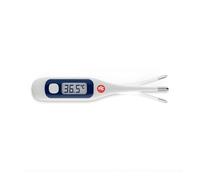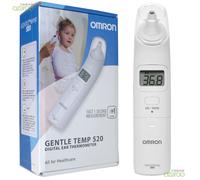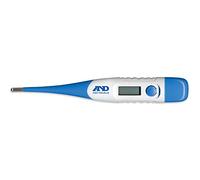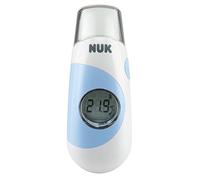Note: This text was created with the help of AI.








































- 1
- 2
- 3
- 4
- 5
- next page
Exclusive Offers for Clinical Thermometers
The different types of fever thermometers work on different principles. On the one hand, there are contact thermometers that determine the temperature by direct contact with the body. This variant includes, on the one hand, gallium thermometers. These contain a mixture of liquid metals. As the temperature increases, the metal expands and moves along a printed temperature scale. Digital thermometers are another form of contact thermometer. There is a sensor in the measuring tip. The result is displayed on a screen.
Infrared thermometers work almost without contact. With these, an infrared sensor measures the radiation. The device converts the values into a temperature. Here too, the readings are displayed on a screen.
There are two groups: contact thermometers and infrared thermometers. The former includes gallium thermometers, which consist of a glass body in which there is liquid metal. A digital clinical thermometer is also considered a contact thermometer. Different measuring methods are possible with both variants.
The second group are fever thermometers, which use infrared radiation to take a measurement almost without contact. This is divided into ear thermometers, where the measurement takes place in the ear, and forehead thermometers, which you point at the forehead to measure. There are also practical devices that come with an attachment that allows you to turn the ear thermometer into a forehead thermometer.
There are also basal thermometers. These measure the body's waking temperature to two decimal places. This variant is mainly used in the symptothermal method, a natural form of contraception in which the woman calculates her fertile days on the basis of her body temperature and the consistency of the cervical mucus. Accordingly, a basal thermometer can also be helpful when planning pregnancy.
The measurement time depends on the type of thermometer. While an infrared thermometer provides you with the measurement results within seconds for both ear and forehead measurement, the temperature measurement with a contact thermometer takes several minutes.
f you use an electronic thermometer, the measurement time varies from device to device. You can find information on this in the manufacturer's instructions for use. Many models conveniently emit a signal tone when the measurement is finished.
With gallium thermometers you have to keep an eye on the time yourself. The measurement time depends on the measurement method - i.e. on which part of the body you are taking the temperature:
- Rectally - about four minutes.
- Oral - about five minutes.
- Axillary - eight to ten minutes.
Contact thermometers, on which you can read the result digitally, offer you the highest measurement accuracy. The rectal measurement is particularly precise. But the measurement under the tongue is also relatively accurate. When measuring in the armpit, inaccuracies can quickly occur, as you usually do not succeed in pressing your arm against your body the entire time.
Infrared thermometers have the advantage that they measure the temperature within seconds. The measurement in the ear canal also provides good results. However, these can be falsified, for example, by a middle ear infection. Wrong measurements sometimes occur with forehead thermometers.
Taking a temperature in the bottom with a digital thermometer is also the most reliable option for babies. Measuring under the tongue and under the armpit is only suitable for children from the age of four and six years respectively.
Rectal measurement is usually unpleasant for the little ones and requires some parental skill. If your baby is older than three months, you can also use an ear thermometer. The quick measurement saves both children and parents some stress. With a forehead thermometer, you can take a temperature even when your baby is asleep, sometimes within just one second. However, the measuring accuracy is not as good as with a digital thermometer.
There are also so-called 'nipple thermometers', especially for babies. As the name suggests, these are teats with a built-in thermometer. In theory, this measures the body temperature while your child sucks on it. In practice, however, this does not work so well, because the teat does not reach far enough into the mouth and babies usually do not keep it long enough in the closed mouth.
For adults, the recommendation is quite clear: digital thermometer. It is best to use this for rectal measurement in the anus or oral under the tongue.
You clean the measuring tip of contact thermometers with warm soapy water and a cloth. Disinfection is particularly important after rectal measurement. It is best to use a cotton pad soaked in rubbing alcohol for disinfecting and hygienic care of the device.
Ear thermometers usually have disposable protective caps that you change after each measurement. If not, treat them carefully with rubbing alcohol.
Many devices draw their energy from button cells with a voltage of 1.5 volts. Some require AAA batteries as a power source and others AA batteries.
You can find detailed information about the type of batteries and how many batteries each model requires in the product descriptions or in the manufacturer's instructions.
If you are disposing of your old thermometer that contains mercury, the normal waste bin is not the answer. The liquid metal, when released, is harmful to both human health and the environment. For this reason, clinical thermometers with mercury belong in hazardous waste or toxic waste collection.
You can put digital and infrared thermometers in the residual waste. However, it is more exemplary if you dispose of them as electrical waste.
Empty batteries have no place in household waste. Dispose of them in the designated collection boxes in a supermarket or drugstore near you.
Exclusive Offers for Clinical Thermometers
When it comes to keeping track of your health, clinical thermometers are essential tools that help you monitor body temperature with accuracy. At pricehunter.co.uk, you can find a variety of offers ranging from reliable digital options to advanced smart thermometers. Understanding the different types available allows you to make an informed choice that suits your specific needs.Types of Clinical Thermometers
Clinical thermometers come in various types, each tailored to particular requirements. Selecting the right type can enhance your monitoring experience.- Digital Thermometer Oral - Ideal for accurate oral readings.
- Infrared thermometers - Non-contact and quick readings, perfect for kids.
- Forehead thermometers - User-friendly and great for quick scans.
- Ear thermometers - Accurate for temperature readings from the eardrum.
- Wearable thermometers - Convenient for continuous monitoring over time.
Popular Brands
Brand reputation plays a significant role in ensuring the quality and reliability of clinical thermometers. Selecting a trusted brand can provide peace of mind about the accuracy of your readings.- Braun Thermometer Ear - Known for precision in ear measurements.
- Omron - Offers a wide range of healthcare products, including thermometers.
- Care of - Provides user-friendly, accurate devices designed for all ages.
- iHealth - Focuses on smart technology integration in health monitoring.
- Exergen - Renowned for its infrared thermometers, emphasizing innovation.
Essential Features to Consider
When choosing a clinical thermometer, certain features can significantly affect usability and accuracy. It's essential to understand what options best suit your lifestyle.- Braun Thermoscan LF40 - Features pre-warmed tip for enhanced accuracy.
- Fast reading time - Look for models that deliver readings in seconds.
- Memory function - Useful for tracking temperature changes over time.
- Backlit display - Makes it easier to read results in low light.
- Water-resistant or washable - Essential for hygiene and easy cleaning.
Smart Technology Integration
Smart thermometers are revolutionizing the way we monitor temperature. These devices provide advanced features catering to tech-savvy users.- Braun Age Precision® Digital - Offers different temperature ranges for various age groups.
- App connectivity - Allows for easy tracking and sharing of data with healthcare providers.
- Voice prompts - Ideal for those who prefer auditory guidance during readings.
- Multi-user profiles - Great for families needing to track multiple temperatures.
- Bluetooth integration - Syncs data seamlessly with smartphones and tablets.
Usage Scenarios and Target Audiences
Understanding the intended audience for different thermometers can help you choose the most appropriate one for your needs. Various situations call for specific features.- Braun Thermoscan 7+ - Perfect for families with young children.
- Home healthcare - Essential for monitoring ongoing health conditions.
- Fitness enthusiasts - Useful for tracking body temperature during workouts.
- Caregivers - Designed for elderly patients needing routine temperature checks.
- Parents - Ideal for quick and easy readings for kids of all ages.
Note: This text was created with the help of AI.